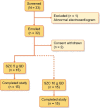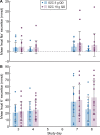Effects of sodium zirconium cyclosilicate on sodium and potassium excretion in healthy adults: a Phase 1 study
- PMID: 34345416
- PMCID: PMC8323143
- DOI: 10.1093/ckj/sfaa237
Effects of sodium zirconium cyclosilicate on sodium and potassium excretion in healthy adults: a Phase 1 study
Abstract
Background: Sodium zirconium cyclosilicate (SZC; formerly ZS-9) is a potassium (K+) binder for treatment of hyperkalemia in adults. SZC binds K+ in exchange for sodium (Na+) or hydrogen (H+) in the gastrointestinal tract, conveying potential for systemic absorption of Na+.
Methods: This single-center Phase 1 study evaluated the effects of SZC on Na+ and K+ excretion in healthy, normokalemic adults. During an initial run-in period (Days 1-2), participants started a high K+/low Na+ diet. After baseline (Days 3-4), SCZ 5 or 10 g once daily (QD) was administered (Days 5-8). The primary endpoint was mean change in urinary Na+ excretion from baseline (Days 3-4) to the treatment period (Days 7-8).
Results: Of 32 enrolled participants, 30 entered and completed the study; the first 15 received 5 g and the next 15 received 10 g. Nonsignificant changes from baseline in urinary Na+ excretion were observed with SZC 5 g (mean ± SD -0.93 ± 25.85 mmol/24 h) and 10 g (-5.47 ± 13.90 mmol/24 h). Statistically significant decreases from baseline in urinary K+ excretion (mean ± SD -21.17 ± 21.26 mmol/24 h; P = 0.0017) and serum K+ concentration (-0.25 ± 0.24 mmol/L; P = 0.0014) were observed with the 10-g dose. There were few adverse events and no clinically meaningful changes in vital signs or laboratory safety measures.
Conclusions: Treatment with SZC 5 or 10 g QD reduced serum K+ concentration and urinary K+ excretion, with no significant effect on urinary Na+ excretion, and was well tolerated.
Keywords: Phase 1 study; excretion; hyperkalemia; potassium; sodium; sodium zirconium cyclosilicate.
© The Author(s) 2020. Published by Oxford University Press on behalf of ERA-EDTA.
Figures





Similar articles
-
Sodium Zirconium Cyclosilicate among Individuals with Hyperkalemia: A 12-Month Phase 3 Study.Clin J Am Soc Nephrol. 2019 Jun 7;14(6):798-809. doi: 10.2215/CJN.12651018. Epub 2019 May 20. Clin J Am Soc Nephrol. 2019. PMID: 31110051 Free PMC article.
-
Phase I Study of the Pharmacodynamics and Safety of Sodium Zirconium Cyclosilicate in Healthy Chinese Adults.Clin Pharmacol Drug Dev. 2022 Mar;11(3):348-357. doi: 10.1002/cpdd.1055. Epub 2022 Jan 8. Clin Pharmacol Drug Dev. 2022. PMID: 34997825 Free PMC article. Clinical Trial.
-
Efficacy and safety of sodium zirconium cyclosilicate for hyperkalaemia: the randomized, placebo-controlled HARMONIZE-Global study.ESC Heart Fail. 2020 Feb;7(1):54-64. doi: 10.1002/ehf2.12561. Epub 2020 Jan 15. ESC Heart Fail. 2020. PMID: 31944628 Free PMC article. Clinical Trial.
-
Effects and Safety of a Novel Oral Potassium-Lowering Drug-Sodium Zirconium Cyclosilicate for the Treatment of Hyperkalemia: a Systematic Review and Meta-Analysis.Cardiovasc Drugs Ther. 2021 Oct;35(5):1057-1066. doi: 10.1007/s10557-020-07134-2. Epub 2021 Jan 18. Cardiovasc Drugs Ther. 2021. PMID: 33459923 Free PMC article.
-
Sodium Zirconium Cyclosilicate: A Review in Hyperkalaemia.Drugs. 2018 Oct;78(15):1605-1613. doi: 10.1007/s40265-018-0991-6. Drugs. 2018. PMID: 30306338 Free PMC article. Review.
Cited by
-
Effect of Sodium Zirconium Cyclosilicate on Serum Potassium and Bicarbonate in Patients with Hyperkalemia and Metabolic Acidosis Associated with Chronic Kidney Disease: Rationale and Design of the NEUTRALIZE Study.Nephron. 2022;146(6):599-609. doi: 10.1159/000523911. Epub 2022 Apr 22. Nephron. 2022. PMID: 35462371 Free PMC article. Clinical Trial.
-
Dose effect analysis of sodium zirconium cyclosilicate in hemodialysis patients.Hemodial Int. 2022 Apr;26(2):274-277. doi: 10.1111/hdi.12983. Epub 2021 Dec 19. Hemodial Int. 2022. PMID: 34927340 Free PMC article. No abstract available.
-
Utilization of non-plasticized polymer inclusion membrane for highly selective colorimetric sensor detection of zirconium in environmental samples.RSC Adv. 2025 Feb 18;15(7):5462-5475. doi: 10.1039/d4ra05674d. eCollection 2025 Feb 13. RSC Adv. 2025. PMID: 39967881 Free PMC article.
-
Safety and efficacy of sodium zirconium cyclosilicate for the management of acute and chronic hyperkalemia in children with chronic kidney disease 4-5 and on dialysis.Pediatr Nephrol. 2024 Apr;39(4):1213-1219. doi: 10.1007/s00467-023-06176-6. Epub 2023 Oct 20. Pediatr Nephrol. 2024. PMID: 37857905
-
Effectiveness, safety, and treatment pattern of sodium zirconium cyclosilicate in Chinese patients with hyperkalemia: interim analysis from a multicenter, prospective, real-world study (Actualize Study).Front Pharmacol. 2024 Jul 29;15:1398953. doi: 10.3389/fphar.2024.1398953. eCollection 2024. Front Pharmacol. 2024. PMID: 39135788 Free PMC article.
References
-
- Kovesdy CP. Management of hyperkalaemia in chronic kidney disease. Nat Rev Nephrol 2014; 10: 653–662 - PubMed
-
- Linder KE, Krawczynski MA, Laskey D.. Sodium zirconium cyclosilicate (ZS-9): a novel agent for the treatment of hyperkalemia. Pharmacotherapy 2016; 36: 923–933 - PubMed
-
- Betts KA, Woolley JM, Mu F. et al. The prevalence of hyperkalemia in the United States. Curr Med Res Opin 2018; 34: 971–978 - PubMed
LinkOut - more resources
Full Text Sources

